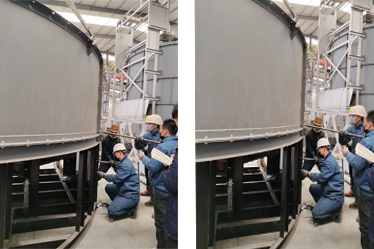Main components and structure of high-temperature aerobic fermenter
2022-12-06
Tank body: mainly used to cultivate and ferment various thallus, with good sealing (to prevent thallus from being polluted).
There is stirring pulp in the tank for continuous stirring during fermentation.
The bottom aerated sprayer is used to pass in the air or oxygen needed for the growth of thallus.
The top plate of the tank has control sensors, the most commonly used are pH electrode and DO electrode, used to monitor the fermentation fluid during fermentation. PH and DO change controllers, used to display and control fermentation conditions, etc.
Structure of a high-temperature aerobic fermenter:
1. Tank body: The volume of the high-temperature aerobic fermenter used in the laboratory is generally a few liters to dozens of liters, and the tank body is usually made up of glass.
2. Detection device:
(1) Temperature probe: to monitor the temperature change during the culture process.
(2) dissolved oxygen electrode: directly immersed in the fermentation liquid to monitor the dissolved oxygen change in the fermentation liquid.
(3) pH electrode: to be directly immersed in the fermentation broth to monitor the change of pH in the fermentation broth.
3. Solvent oxygen control system:
(1) Air flowmeter: manually adjust the dissolved oxygen level in the fermentation liquid by adjusting the size of the air flow rate.
(2) Mixing motor and mixing linkage device: the mixing motor provides rotating power to drive the mixing linkage device to rotate; The leaves of the latter stir the fermentation liquid, break up bubbles, increase the contact interface between gas and liquid, and thus improve the dissolved oxygen level.
4. Temperature control system: including the cooling water pipe at the bottom of the tank and the condenser at the air outlet. Because heat is usually produced during fermentation, the cooling water can maintain a constant temperature.
5. Acid-base balancing device: The acidic or alkaline solution can be pumped into the fermentation liquid through the peristaltic pump to adjust its pH value.

There is stirring pulp in the tank for continuous stirring during fermentation.
The bottom aerated sprayer is used to pass in the air or oxygen needed for the growth of thallus.
The top plate of the tank has control sensors, the most commonly used are pH electrode and DO electrode, used to monitor the fermentation fluid during fermentation. PH and DO change controllers, used to display and control fermentation conditions, etc.
Structure of a high-temperature aerobic fermenter:
1. Tank body: The volume of the high-temperature aerobic fermenter used in the laboratory is generally a few liters to dozens of liters, and the tank body is usually made up of glass.
2. Detection device:
(1) Temperature probe: to monitor the temperature change during the culture process.
(2) dissolved oxygen electrode: directly immersed in the fermentation liquid to monitor the dissolved oxygen change in the fermentation liquid.
(3) pH electrode: to be directly immersed in the fermentation broth to monitor the change of pH in the fermentation broth.
3. Solvent oxygen control system:
(1) Air flowmeter: manually adjust the dissolved oxygen level in the fermentation liquid by adjusting the size of the air flow rate.
(2) Mixing motor and mixing linkage device: the mixing motor provides rotating power to drive the mixing linkage device to rotate; The leaves of the latter stir the fermentation liquid, break up bubbles, increase the contact interface between gas and liquid, and thus improve the dissolved oxygen level.
4. Temperature control system: including the cooling water pipe at the bottom of the tank and the condenser at the air outlet. Because heat is usually produced during fermentation, the cooling water can maintain a constant temperature.
5. Acid-base balancing device: The acidic or alkaline solution can be pumped into the fermentation liquid through the peristaltic pump to adjust its pH value.

We use cookies to offer you a better browsing experience, analyze site traffic and personalize content. By using this site, you agree to our use of cookies.
Privacy Policy



